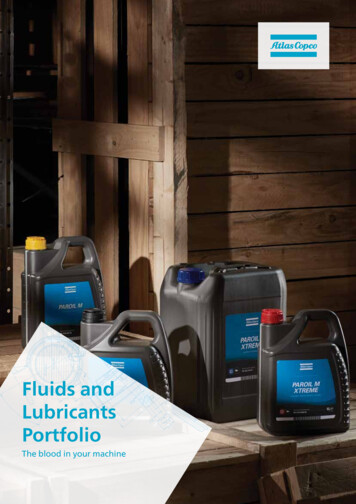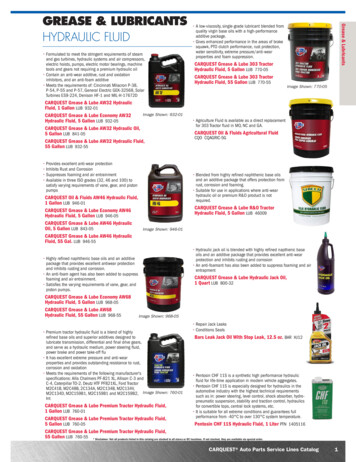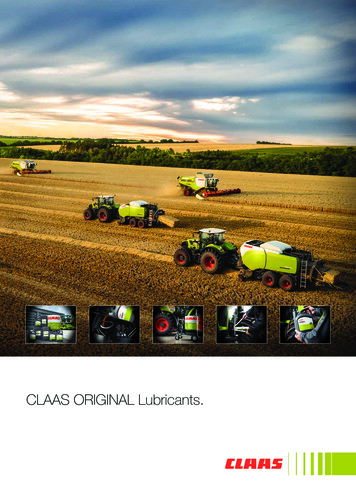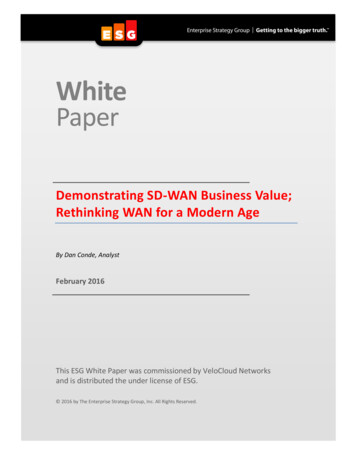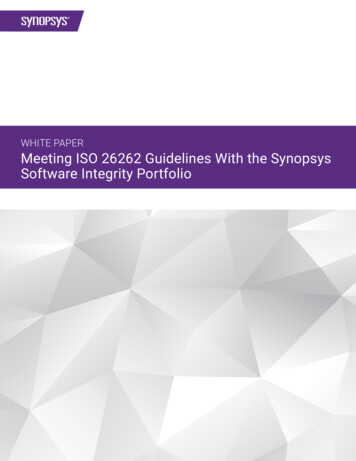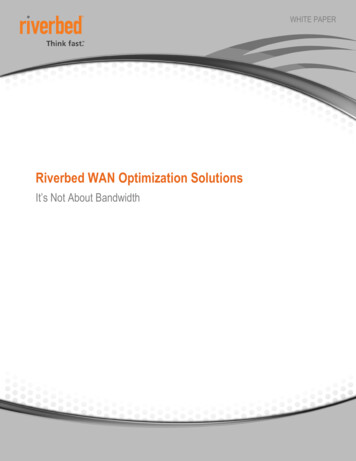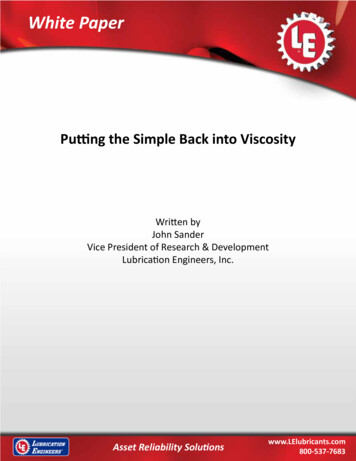
Transcription
White PaperLE WHITE PAPERPutting the Simple Back into ViscosityPutting the Simple Back into ViscosityWritten byJohn SanderVice President of Research & DevelopmentLubrication Engineers, Inc. 2019 Lubrication Engineers, Inc.Asset Reliability Solutions1www.LElubricants.com800-537-7683
LE WHITE PAPERPutting the Simple Back into ViscosityAbstract:Simply stated, viscosity is defined as the internal resistance of a fluid to flow. That doesn’t sound toodifficult, does it? Unfortunately, new temperature, speed and pressure demands on lubricating fluids have changedover the years, resulting in several different measurements and classifications being created to describe lubricantviscosity. Some examples are SUS, cSt, cP, ISO, SAE engine, SAE gear and AGMA; it’s enough to make a person’s headstart to spin. This paper will summarize some of the more commonly used viscosity standards, describe the testsused to measure viscosity, and eliminate some of the confusion all of these standards may create for the end user.IntroductionIn recent years, some large lubricant marketers have run advertisements on TV that highlight the importance ofviscosity breakdown. These advertisements make it seem like viscosity is a complex chemical property of the fluid,when in fact it is a measurement of a physical property. Simply stated, viscosity is a measure of a fluid’s internalresistance to flow. A good example of this was provided in one of the TV ads, which showed two oils being cooleduntil one continued to flow out of the bottle readily, while the second dropped out in blobs. The resistance to flow,or viscosity, of the second oil had increased dramatically with the decrease in temperature. This ad illustrated justhow important it is to consider viscosity when choosing the proper lubricant for a specific application.The presence of viscosity information on almost all lubricant marketers’ technical literature is an indication that italso is important in the marketing of lubricants. Original equipment manufacturers often specify the lubricant to beused in their equipment by product type and viscosity. Lubricant marketers usually sell their lubricants according tospecific viscosity grades, such as SAE 15W40, ISO 46 and AGMA 3.It is clear that – for the majority of the players in the lubricant industry – the proper viscosity of a fluid is the mostimportant attribute in proper lubrication. There are several reasons for this, including, but not limited to: Viscosity affects fluid film thickness under certain conditions of temperature and load inlubrication applications. Viscosity affects heat generation and removal in bearings, cylinders and gears. Viscosity determines the ease with which machines can be started in low-temperature conditions orcan be kept running in high-temperature conditions. Viscosity can be used to control a fluid’s sealing ability, which results in lower consumption.Viscosity DefinedAs mentioned above, viscosity is a physical measurement of a fluid’s internal resistance to flow. Assume that alubricating fluid is compressed between two flat plates, creating a film between the plates. Force is required tomake the plates move, or overcome the fluid’s film friction. This force is known as dynamic viscosity. Dynamicviscosity is a measurement of a lubricant’s internal friction and it is usually reported in units called poise (P) orcentipoise (1 P 100 cP). A common tool used to measure dynamic viscosity is the Brookfield viscometer, whichemploys a rotating spindle that experiences torque as it rotate against fluid friction. This test will be discussed inmore detail later.A more familiar viscosity term is kinematic viscosity, which takes into account the fluid density as a quotient of thefluid’s dynamic viscosity and is usually reported in stokes (St) or centistokes (1 St 100 cSt). The kinematic viscosityis determined by using a capillary viscometer in which a fixed volume of fluid is passed through a small orifice at acontrolled temperature under the influence of gravity.Grease viscosity, traditionally called consistency, cannot be measured using the tests noted above. However, it isstill relevant for selection of the correct grease for a specific application. Greases are fluid lubricants enhanced witha thickener to make them semi-solid. They usually are used in applications where a liquid lubricant would2 2019 Lubrication Engineers, Inc.
LE WHITE PAPERPutting the Simple Back into Viscosityrun out. Greases are sold by consistency grade, which in this case will be used synonymously to viscosity grade.Grease consistency is measured using the cone penetration test. The National Lubricating Grease Institute (NLGI)created grade ranges for greases that have become the industry standard. These ranges characterize the flowproperties of greases.Viscosity ConsiderationsVarious conditions must be considered when specifying the proper viscosity of a lubricant for a given application.These conditions include the operating temperature, the speed at which the specific part is moving, and the loadplaced upon the part. One other consideration is whether or not the lubricant can be contained so that it remainspresent to lubricate the intended moving parts.TemperatureThe viscosity of a lubricant changes with temperature – in almost all cases, as the temperature increases, the viscositydecreases; and – conversely – as the temperature decreases, the viscosity increases. To select the proper lubricant fora given application, the viscosity of the fluid must be high enough that it provides an adequate lubricating film, butnot so high that friction within the lubrication film is excessive. Therefore, when a piece of equipment must be startedor operated at either temperature extreme – hot or cold – the proper viscosity must be considered.SpeedThe speed at which a piece of equipment operates must also be considered when specifying the proper lubricantviscosity. In high-speed equipment, a high-viscosity lubricant will not flow well in the contact zones and will channelout by fast-moving elements of the equipment. On the other hand, low-viscosity lubricant would have too low aviscosity to properly lubricate slow-moving equipment, because it would run right out of the contact zone.LoadEquipment loads must also be considered when selecting the proper lubricant viscosity. Under a heavy load, thelubricant film is squeezed or compressed. Therefore, a higher viscosity lubricant is needed. The higher the viscosity,the more film strength the lubricant will generally possess. In addition, the load can be either a continuous or shockload. A continuous load is a steady load that is maintained while the equipment is operational, while a shock loadis a pounding or non-steady load. Under shock-load conditions, a low-viscosity lubricant would not possess enoughfilm strength to stay in place, whereas a high-viscosity lubricant could stay in place and act like a cushion in thecontact area.ContainabilityIn some applications in which a fluid lubricant would leak out, a grease might be recommended. However, it is stillimportant to consider both the base fluid viscosity and the NLGI grade when selecting the proper lubricant. If thelubricant’s viscosity or consistency is too high, it might not flow where it is needed and the lack of lubricant – acondition known as lubricant starvation – would lead to metal-to-metal contact. This would cause wear that couldultimately result in equipment failure. The same thing could happen with a lubricant with too low a viscosity orconsistency, because it might not stay in the area where it is needed.Viscosity ClassificationsFortunately for the end-user, various technical societies have created classifications that are used by lubricantmanufacturers when formulating the proper viscosity grade of lubricant needed for their equipment. Theseviscosity classification systems are commonly used to describe both industrial and automotive lubricants. Thesestandardized viscosity ranges are used by lubricant formulators, original equipment manufacturers and lubricantconsumers when labeling, marketing, specifying and using lubricants. 2019 Lubrication Engineers, Inc.3
LE WHITE PAPERPutting the Simple Back into ViscosityFluid Lubricant Viscosity ClassificationsThe Society of Automotive Engineers (SAE) has created two viscosity standards for automotive lubricants. SAE J300is a viscosity classification for engine oils, and SAE J306 is for axle and manual transmission lubricants. The J300viscosity grades and their requirements are summarized in Table 1, while those for J306 are shown in Table 2. Inboth of these classifications, the grades denoted with the letter “W” are intended for use in applications operatingin low-temperature conditions. The “W” was originally coined for lubricants that were considered “winter grade.”Today, these products are formally called multigrade lubricants, whereas the grades without a “W” are recognizedas monograde, or straight grade, lubricants.TABLE 1 – SAE J300 Viscosity Grades for Engine Lubricants (1)SAEViscosityGradeLow-Temp ( C)Cranking Viscosity,cP MaxLow-Temp ( C)Pumping Viscosity,cP Max withno yield stressKinematicViscosity (cSt)at 100 C MaxKinematicViscosity (cSt)at 40 C MaxHigh ShearViscosity (cP)at 150 C Min0W5W10W15W20W25W2030404050603250 @ -303500 @ -253500 @ -203500 @ -154500 @ -106000 @ -5-60,000 @ -4060,000 @ -3560,000 @ -3060,000 @ -2560,000 @ -2060,000 @ -15-3.83.84.15.65.69.35.69.312.512.516.321.9 9.3 12.5 16.3 16.3 21.9 26.12.62.92.9*3.7**3.73.7* For 0W40, 5W40 and 10W40 Grades** For 15W40, 20W40, 25W40 and 40 GradesTABLE 2 – SAE J306 Viscosity Grades for Axle and Manual Transmission Lubricants (2)SAE ViscosityGradeMaximum Temperaturefor Viscosity of 150,000 cP CViscosity at100 C cSt MinimumViscosity at100 C cSt 4.14.17.011.07.011.013.518.524.032.541.0 11.0 13.5 18.5 24.0 32.5 41.0-Industrial fluids are also specified according to various viscosity classifications. The most frequently used industrialviscosity classification was jointly developed by ASTM International and the Society of Tribologists and LubricationEngineers (STLE). It was recognized as ASTM D2422. This method originally standardized 18 different viscosity gradesmeasured at 100 F in Saybolt Universal Seconds (SUS). It was later converted to more universally accepted metricsystem values measured at 40 C. The system eventually received international acceptance. These viscosity ranges aredenoted in Table 3 and are usually recognized as “ISO viscosity grade numbers,” often shortened to “ISO VG numbers.”4 2019 Lubrication Engineers, Inc.
LE WHITE PAPERPutting the Simple Back into ViscosityTABLE 3 – ISO Viscosity Grades for Industrial Oils (3)ISO Viscosity ematic Viscosity at 40 C, Min 1982884146129001350Kinematic Viscosity at 40 C, Max 4235250674811001650The American Gear Manufacturers Association (AGMA) has also created a commonly used viscosity classificationsystem, which is partially based off the ISO VG system, noted in Table 4. The AGMA numbers let the user know theISO viscosity grade and some basic information about the gear lubricant’s chemistry. If the product is a mineraloil that contains only rust and oxidation (R&O) additives, it will be recognized with only the AGMA number. If itis a mineral oil with extreme pressure additives, it is recognized with the AGMA number followed by the “EP”designation. AGMA numbers followed by an “S” denote synthetic gear oils. Compounded gear oils contain 3% to 10%fatty or synthetic fatty oils and are noted by the AGMA number with “Comp” after it. Some gear oils contain residualcompounds called diluent solvents that are used to temporarily reduce the viscosity making it easier to apply. In thiscase, the AGMA number is followed by an “R,” which describes product prior to addition of diluents solvent.Table 4 – AGMA Viscosity Grades for Gear Oils (4)AGMA NumberISO GradeEquivalent0, 0S1, 1S2, 2EP, 2S3, 3EP, 3S4, 4EP, 4S5, 5EP, 5S6, 6EP,6S7, 7Comp, 7EP, 7S8, 8 Comp, 8EP, 8S8A Comp, 8A EP9, 9EP, 9S10, 10EP, 10S11, 11EP, 11S12, 12EP, 12S13, 13EP, 13S14R15R32466810015022032046068010001500- 2019 Lubrication Engineers, Inc.KinematicViscosity at 40 CMin 0-KinematicViscosity at 40 CMax 480-KinematicViscosity at 100 CMin cSt190428.5857.0KinematicViscosity at100 C Max cSt220857.01714.05
LE WHITE PAPERPutting the Simple Back into ViscosityNow do all of these viscosity grades seem easier to understand? Okay, maybe not yet, so Table 5, a viscosity equivalentchart, provides a comparative illustration of all of the grades shown in tables 1 through 4. For example, the chartindicates that an SAE 50 engine oil and an SAE 90 gear oil are the same viscosity. This might surprise you if you’rethinking that gear oil is always thicker than engine oil. However, as shown in the table, they are nearly equivalent.6 2019 Lubrication Engineers, Inc.
LE WHITE PAPERPutting the Simple Back into ViscosityAs with anything, viscosity classifications have changed over time. As mentioned above, viscosity used to becommonly recorded in SUS units in the United States. As the economy has become more global, different standardsorganizations have worked together to standardize units of measure, including viscosity units. Some olderequipment is still in operation that specifies the lubricant viscosity in the older units. The OEM might designateit with SUS units, while end users might refer to it in “seconds,” e.g. “I need a 100-second oil for this machine.”Fortunately, there are common conversions that can be used to estimate the cSt value from the SUS value.Grease Consistency ClassificationsIn some lubricant applications, it is impossible
SAE J300 is a viscosity classification for engine oils, and SAE J306 is for axle and manual transmission lubricants. The J300 viscosity grades and their requirements are summarized in Table 1, while those for J306 are shown in Table 2. In both of these classifications, the grades denoted with the letter “W” are intended for use in applications operating in low-temperature conditions. The .
